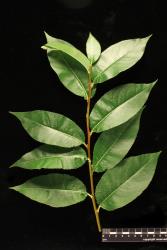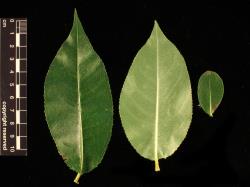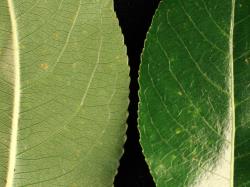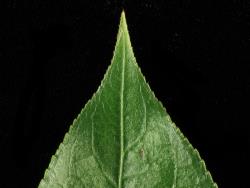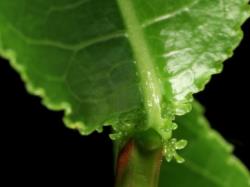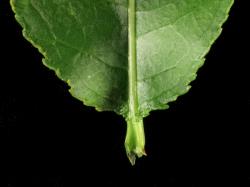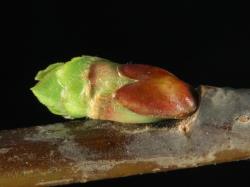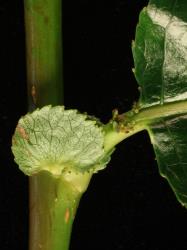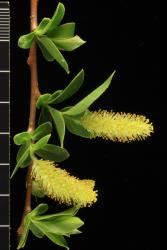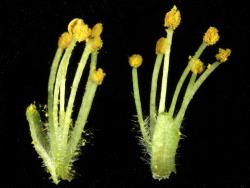Trees 5–16 m tall, bark of trunk greyish brown, shallowly fissured. Current year's branchlets glabrous, dark red to dark reddish brown (UCL16–44). Year-old branchlets mid- to strong-brown (UCL55–58), glabrous, 3.0–3.5 mm diameter. Flower buds ca. 5.0 mm long, 3.0 mm wide, 1.8 mm deep, ovoid, angled on 2 sides, red-brown (UCL43), glabrous. Stipules persistent, ca. 1.5 mm long in spring, up to 9 mm long in summer and kidney-shaped. Petiole 5–12 mm long, glabrous, yellow-green, adaxial groove present, glands 8–15, green or brown, clustered at top of petiole. Emerging leaves green, glabrous or with long-silky hairs. Proximal leaves toothed. Leaf lamina glabrous, 96–162 mm long, 41–79 mm wide, length to width ratio 1.3–2.8:1, ovate, not falcate; base truncate; apex acuminate; leaf galls absent or sparse; orange rust absent in late summer; margins densely serrulate, flat; upper lamina surface dark green, moderately to very glossy, stomata absent to moderately dense especially near veins, midvein raised, otherwise smooth; lower lamina surface not glaucous, silvery green due to dense stomata, midvein and side-veins raised, netted veins visible. Catkins emerging coetaneously with leaves. Flowering branch 40–110 mm long, with 5–9 reduced leaves, sometimes with 1 cataphyll. Male catkin 26–35 mm long, 10–11 mm diameter; catkin rachis visible between flowers. Female catkin 42–65 mm long, 7–15 mm diameter; catkin rachis visible between flowers. Flower bract 1.9–2.6 mm long, 0.9–1.1 mm wide, pale green, slightly channelled at base, narrowly obovate; apex 3–4-toothed, teeth gland-tipped, deciduous in female flowers. Male nectaries 2, inner nectary 0.3–0.7 mm long, 0.16–0.30 mm wide, cylindrical or bilobed, yellow-green turning yellow. Stamens 5–8, filaments free with hairs present at base; anthers 0.4–0.6 mm long, yellow. Female nectaries 2, 0.5 mm long, 0.4 mm wide, sometimes unequally lobed; ovary 3.0 mm long, glabrous; stipe 0.4 mm long; style base 1.0 mm long, style arms 0.3 mm long, lobed half their length.
A tree 10–16 m tall. Leaves ovate, elliptical or oblong-elliptical, with an acuminate tip and truncate base, the upper surface very glossy, waxy and dark green, texture thick and rigid; leaves not glaucous below but silvery green due to dense stomata; margins finely and densely rounded-serrate, teeth towards leaf base are glandular and extend onto the petiole, where there are clusters of glands sometimes like bunches of grapes. Leaves (including bud leaves) completely glabrous but the reduced leaves below the catkins may have long-silky hairs on the margins. Sometimes with sparse red leaf galls. Flower bracts green, obovate, and toothed at the apices. Stamens are 5. Ovaries are glabrous. Brown hairs are present on the catkin axis in ca. 50% of European specimens and have been seen on the reduced leaves below catkins in New Zealand plants.
Most similar to Salix ×meyeriana (the hybrid of S. pentandra × S. euxina), sharing glabrous, very glossy, waxy, hard leaves, clusters of glands at the lamina base. The 2 differ only in leaf dimensions, S. ×meyeriana having longer, narrower leaves on average. Related to, and in some ways similar to, S. lasiandra, but whereas S. pentandra is from Europe and Russia, S. lasiandra is from North America. Both have a high stamen number, and they share a tendency to have leaf galls, but S. pentandra has a wider leaf (41–79 mm versus 26–34 mm wide). Salix pentandra is not glaucous below, while S. lasiandra is glaucous.
Zinovjev (2011) examined Salix pentandra and S. ×meyeriana in North America and considered that all North American S. pentandra specimens were in fact the hybrid. This was based on his seeing a synthetic hybrid of S. pentandra × S. euxina produced in Yekaterinburg Botanical Garden in the 1960s. He believed that most North American specimens resembled that hybrid of known parentage. He noted that teratogenic flowers were sometimes present. He considered that sawfly gall production on S. pentandra was improbable. New Zealand S. pentandra plants commonly have sawfly galls. PN670 can produce a second, very reduced ovary beside the normal ovary, a teratological feature that lends some support to Zinovjev's observations.
In cultivation known from Gisborne (Hackfalls Arboretum 1991), Southern North Island (Aokautere), Canterbury (Bluecliff Station 1981).
First collection: CHR 616363, B. Molloy, March 2001, Canterbury, Lake Ōhau, Freehold Creek.
First publication: Kraayenoord & Hathaway (1986).
Flowering: Late October–late December. The last Salix species in New Zealand to flower.
Tetraploid, 2n = 76 (CCDB based on 13 counts). Flow cytometry provisionally confirms tetraploidy using PN253, PN271, and PN670.



